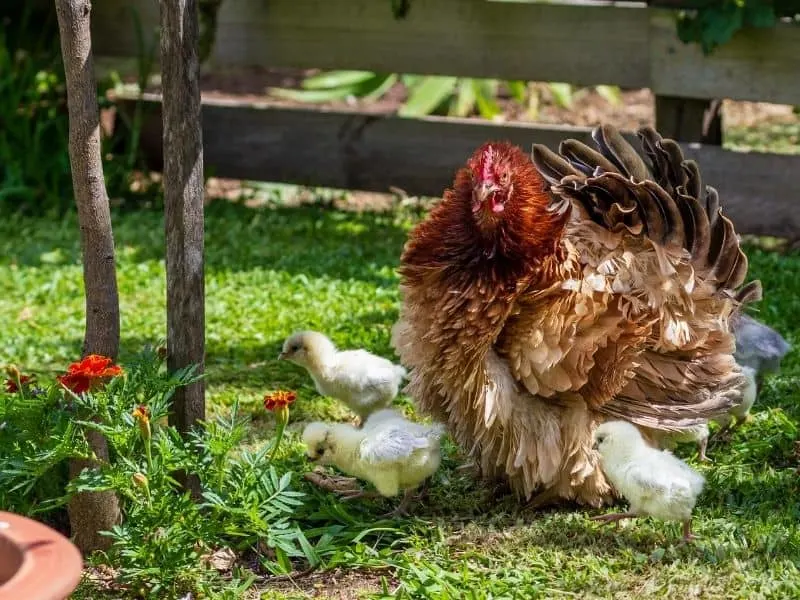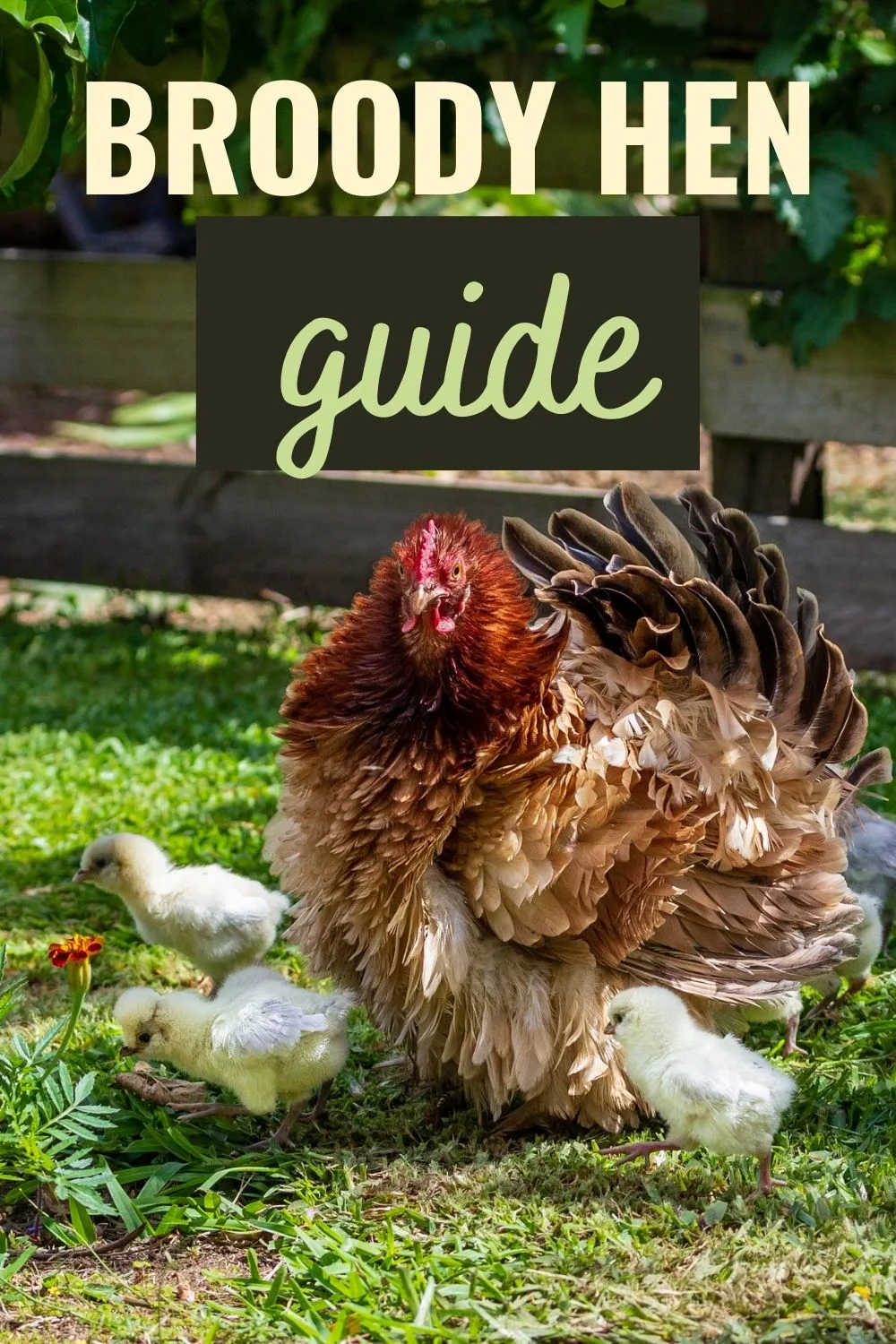There is nothing more beneficial to your homestead than a broody hen. Watching a mama hen nurture and raise baby chicks is a joy and an integral part of self-sustainability. As you become more familiar with chickens and you watch your flock grow up, you may notice one or two (or more) of your hens is acting a bit strangely. It is very possible she may be going broody.

So you have a broody hen, what now?
Broody Hen Guide
What is broodiness?
As a hen matures, her desire to carry on the species may become strong. The need to sit and hatch out eggs is a natural and common occurrence in many breeds of chickens. Some are more prone to go broody than others and we will discuss the broodier breeds in a minute.
When a hen decides to go broody, she becomes dedicated to incubating eggs in order to hatch them and cares for her nestlings with no interruption until they are ready, which is about 21 days after hatching.
What are the signs? Broody hen symptoms
When a hen goes broody her demeanor, attitude and personality will change. Here are some signs that you have a broody hen:
- constantly sitting in the nesting box in a trance like state
- not wanting to move from the box when encouraged, oftentimes puffing up and growling or pecking at you to leave her alone
- some hens will pluck the feathers from their chest to provide closer contact to the eggs which transmits heat more efficiently
- when she does leave the nest she will stay puffed up and make a constant clucking sound to warn the other chickens to stay away from her
- as she progresses in the broody process you may see her comb and wattle color start to fade and weight drop as she focuses all of her attention on incubating the eggs
- she will stop laying eggs
What do I do with my broody hen?
You have two options:
- let her sit on some fertilized eggs and become a mama
- break her of the broody spell
1. Let her become a mama
If you decide to let her go through with the process here are a few tips to make the experience stress free and successful:
If she has decided to go broody in the main coop you will want to move her to a different location. The main reason for this is to cut down on stress and make sure the eggs do not get damaged or broken.
When a hen goes broody in the coop the other hens will constantly harass her in the nest as they try to lay their eggs, especially if she is lower in the pecking order. This will create a chaotic environment that is not conducive to a successful brooding process.
I will put my broody hen in a large plastic dog crate, the kind used for kenneling dogs on airplanes. They are roomy enough to put her nest at the back and her food and water at the front. You will want to place these away from where she is sitting to encourage her to get up off the nest to eat and drink.
Also, a broody hen will do something we in the chicken world affectionately call a broody poop. Hens on the nest will sometimes sit for days without moving or having a bowel movement. When they finally do get off the nest to do their business it will be the biggest, stinkiest experience you’ve ever witnessed. This is why you want her to move off the eggs. If there is not enough room she may soil the nest and the eggs which could potentially render them unviable. You’ll need to keep the crate clean and dry for the entire process to ensure the best results.
When setting eggs under your broody hen, make sure she can cover all of the eggs comfortably. Too many eggs will affect the hatch rate. She needs to be able to warm all of the eggs equally.
For a full-sized hen, let’s say a Buff Orpington, 10-12 large eggs should be sufficient. If you have a bantam hen on eggs, you’ll want to give her less. Typically my bantams can handle between 4-6 large eggs. FB course if your hen is incubating small eggs she may be able to handle more.
I will normally candle the eggs at day seven to check for growth. This is a good practice because it allows you to remove any eggs that are not growing which will give her more room for viable eggs. You will want to candle the eggs at night when she is less likely to become agitated. Also, it is easier for you to see inside the egg in a dark environment. You’ll want to look for veining and the “eye” which is the embryo starting to form. The air sac will be prominent as well. I will candle again around day 14 just to make sure everything is still on track and remove those that have “quit” or stopped progressing.
After day 18 you will want to leave her be. She will enter what is called the lockdown phase in preparation for the hatching. This point in the brooding process becomes important because the humidity levels beneath the hen will begin to rise and moving her can upset the delicate balance needed for a successful hatch.
Between days 19-21 chicks should begin pipping and preparing to unzip from their egg and enter the world. You will notice your hen will start a low clucking sound as she talks to her babies and encourages them to hatch. It really is very sweet. At about day 19-20, I move the food and water close to her so she can begin to teach her already hatched babies to eat and drink without getting off the nest.
Once all babies have hatched she will naturally get up and start to forage for food. If she’s in the crate she will scratch at the bedding material to find things for her babies to eat. This is completely normal and can get messy. After about a week to two weeks in the crate, you will most likely want to transition them to a larger area.
At this point, the babies will become much more active and will need more room to move around in. I use a chicken wire cage I found on FB Marketplace a while back. It is excellent for transitioning and the babies cannot get out of it. You could easily make one out of some boards and wire.
Mama hen will typically stay with her babies for 5-8 weeks and then she will start to distance herself from them and show a desire to return to the flock. Some hens will stay with their babies longer, others less. Just depends on the individual hen. When she begins to lay eggs again she is definitely ready to rejoin the flock.
2. Break her of the broody spell
What if you have a broody hen and do not want her to hatch eggs?
Breaking a hen from being broody can sometimes be difficult and labor-some. I have hens that will sit for a month or two even if I pull the eggs daily.
Some folks will put their hen in a wire bottom crate with food and water to try and break her of the spell. The thought process behind this method is that if the hen doesn’t have a warm, cozy place to sit and nest she will give up on being broody.
The wire bottom makes an inhospitable environment for brooding. Generally keeping her in the cage for a week is recommended when using this method. It would depend on the individual hen though, and the strength of her determination.
Some old-timers will tell you that dunking her in cold water will break the broody spell. I have not tried, nor do I recommend this method. Ever heard the saying “madder than a wet hen”? Well, that’s where that phrase comes from. Whether this actually works or not remains to be seen.
When I have broody hens, (and I’ve got about 15-20 at the moment), I simply pull the eggs and just let her continue to sit until she eventually gets over it. The downside of having broodies when you don’t want them to be broody is that they stop laying eggs.
So you can imagine that having as many broodies as I do will cut down on your egg production. Also with having so many it wouldn’t be practical for me to put them all in wire cages to break them of it. My method works for me, you do what works best for you and your flock.
What makes a good broody?
Every hen has the ability to go broody but not all of them will. And of the ones that do, some make better mamas than others. Breed, age, and disposition can have a lot to do with whether she will make a good broody or not.
As you have probably already determined I have a lot of broody hens on my farm. It is like an epidemic around here. When one goes broody it seems like they ALL go broody. But not all of my hens are good mothers. Determining whether or if she will be successful at the brooding process is a bit of a learning curve.
I break my hens down into three categories: sitters, quitters, and committers. What do these terms mean?
1. Sitter hens
A sitter is a hen who will go broody and sit and sit and sit. She just loves incubating those eggs. I find that my Silkie hens are notorious sitters. They are very good at the incubating process and remain committed through to hatch.
The only downside to a sitter is that she oftentimes not a good mama. She prefers to incubate but raising babies is not her forte. If you get a sitter you may need to be prepared to move the chicks to a brooder once they have hatched.
2. Quitter hens
A quitter is a hen that goes broody and about a week or two in, decides motherhood is not for her, and abandons the nest to go back to her previous lifestyle.
Quitters typically tend to be young hens that have not yet gotten the hang of the whole broody process. If I have quitters in my flock I make a notation as to which hens they are and I do not use them as broodies.
3. Commiter hens
A committer is the gold standard to which all broodies should strive. She is a hen that will take her job seriously, see it through to hatch, and raise the babies up to 5-8 weeks of age. I have several hens on my farm that are in this category. They are what I like to call my workhorses.
As soon as I see them start to get broody I can pull them from wherever they are sitting and place them in a kennel with no issue. They will stay dedicated to the task no matter where I move them. These are the types of hens you want in your flock if you plan to hatch your own chicks. A committed hen can be your farm’s biggest asset.
Best broody hens breeds
Which breeds tend to be broodiest?
Not all breeds are known to go broody but there are some that are famous for wanting to be mamas.
First on the list is without a doubt the Silkie. Silkies are what I like to call notoriously broody. As discussed above, they love to sit. And will do so for long periods of time. They also can be great mamas.
Next up would be your Cochins. Cochin hens are wonderful broodies and I find mine are very much committers. The Orpington makes a great broody as well as your Easter Eggers and Australorps.
Some breeds that are not well known for being broody are your birds that are bred to be heavy egg layers. The instinct to sit has been bred out of them to keep egg production high. When a hen goes broody she stops laying eggs. So if she sits on the eggs for 21 days and then raises the babies for 5-8 weeks, you are looking at 2-3 months of no eggs from that hen.
If she would normally lay 6-7 eggs a week that’s between 60-90 eggs you won’t be collecting from her at that time. The Leghorn, Rhode Island Reds, hybrids such as the Golden Comet, and sexlinks typically are not known for going broody. Of course, there is always an exception to every rule. So, if you want a good broody I wouldn’t count on these birds to do the job for you.
If you’ve never let your hens hatch out eggs, I highly recommend you do so. It can be a very rewarding experience for you and your family. There’s nothing cuter than going down to the coop in the morning and seeing an adorable fluff ball poking out of a mama hen’s wing or sitting on her back. It brings a smile to my face every time, and it never gets old.
FAQs about broodies
What time of year do hens go broody?
It usually happens in the spring or early summer: that way the baby chicks are ready for cooler weather once they grow.
How often do broody hens eat and drink?
They only get up to eat, drink, and relieve themselves a couple of times a day. If it’s really hot, make sure they have water close by their next, or they can easily become dehydrated.
What do you feed a broody hen?
Broodies don’t eat a lot, and since they aren’t laying eggs they don’t need layer feed. Make sure they have clean water and some starter feed (they’ll eat this anyway once their chicks hatch), and maybe some mealworms and bird seeds.
Do hens go broody without a rooster?
Yes, broodiness isn’t connected to having a rooster around. BUT, if you have a broody hen and no rooster, remove her eggs and place some fertilized eggs you buy to replace them, or you won’t get any chicks.
Will broody hens take baby chicks?
If you have a broody hen, you can add a few baby chicks under her and night and most of the time they’ll accept them and care for them.

Sheri Hayden has been raising chickens for over a decade and has gained a wealth of insight into her feathery friends through years of experience and hands-on interaction. She runs Virginia Backyard Chickens, a popular Facebook group about keeping chickens.



How To Care For Baby Chicks - Guide To Raising Chickens In Your Backyard
Monday 27th of March 2023
[…] One concern about broody hens is that not all are dedicated hatching hens. Some may abandon the eggs after a couple of days or even kill the chicks after hatching. Look at her past performances to be sure before investing in expensive hatching eggs. Learn more about broody hens. […]
Quick Guide To Raising Backyard Chickens
Thursday 28th of July 2022
[…] So You Have a Broody Hen: What Now? […]
A Hen Or A Rooster? How Do I Know What My Chick Is? (Pictures)
Friday 18th of March 2022
[…] Related: Broody hens. […]
Scaly Leg Mites In Chickens: Symptoms, Treatment, And Prevention
Friday 11th of March 2022
[…] The mites will travel from one infected bird to another. They will also infect chicks while they sleep under the mama hen. […]